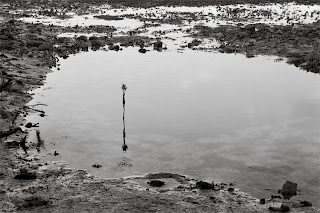
A few days ago I posted my first blog entry in over 3 months. It consisted of little more than explaining the long delay (attributed to "day job" related constraints), highlighting some recent publications, and briefly amplifying on an observation I made in a recent interview. But I left out a deeper thought; one that I think goes to the heart of the creative process. Namely, the degree to which what - not how - we choose to photograph defines who we really are; particularly after a long absence from doing photography. This is a point both obvious and subtle.
It is often said that the best (perhaps only?) way to discover who we really are is to see what we do in moments of crisis. I use the word "crisis" here not to label some profound existential angst or trauma, but simply to denote a "moment of truth"; i.e., some instant in time during which a decision must be made now. Perhaps we've delayed a decision, perhaps the problem or issue facing us is too ill-defined, or maybe a looming deadline is just too far in the future for us to care. But then the deadline comes near, or circumstances change, and a decision must be made right now. Malcolm Gladwell (in his book Blink) calls this thin-slicing, though his use of the term refers specifically to those situations where the person making a decision has very little time to make it. However, for the point I'm trying to make, I'd like to relax this last condition; i.e., I am interested in the "I need to make a decision now" process that allows the decision-maker time to reflect on her decision. Yes, a decision needs to be made (today, and not tomorrow, or next week), but you don't need to "thin slice" your response; rather, give the issue some thought - or take a "reflective slice" - and temper it with intuition. Now, what do you decide to do?
My (hardly original) hypothesis is that what we decide to do under these circumstances tells us a lot about who we really are (stripped of all the usual encrusted layers of decisions past and pending). In the context of photography, the problem is: "OK, Andy, you haven't been out with a camera for a while, and now you have an hour or so to prowl around, where do you go and what do you photograph?" My claim is that what I naturally - intuitively - train my camera's lens on says everything about me as a photographer (and about my creative process) that needs - and/or is ultimately worth - saying.
Paradoxically, the deepest insights come from moments of decision that follow long periods of inactivity. For it is only after we have not done photography for a while that the photography most important to us is best revealed. Immersed (as I usually am) in multiple simultaneous ongoing projects, the day-to-day (and shot-to-shot) decisions collectively sculpt only a fleeting image of a particular period of my creative process, as defined by the needs of specific projects; but they do not easily reveal fundamental truths about me as a photographer. While I may discover details about "what I am doing" by paying attention to what I am doing when "I am doing photography" (at times when I am immersed in doing it), I can only discover the truth that underlies all of my photography (perhaps my entire creative process) by paying attention to what I turn my attention to first after not having done photography for a while. It is only after not doing photography that our attention is naturally and strongly drawn first to what matters most deeply; not subject to the vagaries of whatever projects we have just finished or are next on our agenda.
Look at the first photographs you take after dusting off your camera. What do they say? Wherein lies their true meaning? Most likely it is to be found in what the photograph - as a whole - is about. The details matter little; indeed, because of the inevitable build-up of aesthetic rust, the details are just as likely to obscure the intended meaning as illuminate it. In Zen-like fashion, the time during which a photographer - who may normally be obsessed with rendering the tiniest of details in an image just so - is unable to focus on detail, is actually the best time for achieving the deepest clarity of vision.
And so I discovered (or relearned) a truth I've known for as long as I've been a photographer; perhaps longer, since photography is but another word for "seeing with a camera," and I've been "seeing" the world at least a few years longer ;-) To whit, after months of relative creative inactivity, my attention is first drawn to quiet, simple scenes in familiar locations in local parks; and my eye to humble uncluttered rhythms of basic shapes and tones. Though I will undoubtedly soon resume my journey towards ever-deeper abstractions in subject matter and imagery, I know that my creative heart yearns for nothing so deeply as glimpses of a simple sudden stillness.




